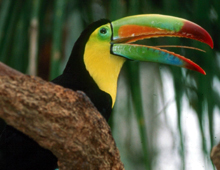Description: The Keel-billed is one of the most colorful of all toucans, with black upper parts and belly, yellow bib and a red breast band. The colorful bill averages 4-6 inches (13-15 cm). The upper mandible is pea green with a wedge-shaped orange area, red tip on both mandibles and a pea green patch at the back of the lower mandible that changes into blue near the tip. “Teeth” are prominent on the beak. The mantle is maroon, the remainder of the back, wings and tail are black (some tail coverts are white and yellow). Eyes are turquoise blue with pale green facial skin. The feet are blue. Sexes look alike but females are somewhat smaller.
Size: Males of this species measure 19-20 inches (48-51 cm) in length and weigh up to 17.6 ounces (500 gr). Females are smaller and have shorter bills.
Behavior: Keel-bills are very social and are seldom solitary, preferring to be in groups of up to 15 birds. Usually found in the upper levels of the forest where they move through the trees by hopping from limb to limb, flying only if necessary.
Diet: Diet consists primarily of fruit, nuts and animal prey (if fruit is scarce, they will feed on insects, lizards, frogs and bird eggs).
Senses: Keel-bills have good eyesight; if there is a sense of smell it is limited.
Communication: Keel-bills, one of the most vocal toucans, chatter continuously. They are reported to make croaking, single note, repetitive variable sounds, including “grr”, “trrii” and “rrrk”. The vocalization may begin as a low sound, that gradually becomes louder, and can often be heard a half-mile or more in open areas. The male sounds are somewhat lower in pitch than those of the females. Wingbeats and bill clacking are among their non-vocal means of communicating.
Reproduction: Nests are natural tree cavities or those made by other birds, such as woodpeckers. They work on the size of the cavity to make it suitable for a clutch size usually of two to four white eggs. The eggs are incubated by both parents for an average period of 18 days. Both parents continue to care for and feed the chicks, with the fledglings staying in the nest for six to nine weeks.
Habitat/range: They are found in moist lowland forests from southern Mexico to Colombia and Venezuela
Status: Least Concern (LC) on IUCN Red list; CITES Appendix II.



